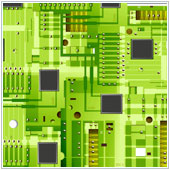No matter where you look, business are going mobile at an increasing rate and a lot of them are going for the laptops. Considering how handy yet powerful these machines are, who can blame them right? This is exactly the reason why you need to equip yourself with basic knowledge about the device. Knowing its parts will not only help you with maximizing its use, it can also help you with maintenance and doing upgrades.
Let’s take a quick look at the five most important parts of every laptop you will hear techies talk about on a regular basis and what they do.
1. Hardware
The hardware is the tangible/physical parts of the equipment. Think about your touchpad, keyboard or basically the body of your laptop and everything contained within. Essentially, every computer part you can touch, or see, is hardware. This includes the device itself and all the physical components that make it up.
2. The Motherboard
A motherboard is where you usually find chips, power connectors, and memory slots (among many others). This board contains the components that make the computer work and is usually located in the center of your laptop with all other parts connected to it. It is also sometimes called the system board or MoBo for short.
If you take your laptop apart – something we don’t advise doing because it will likely void any and all warranties – you should be able to see the outer components of a motherboard, with the memory and hard drive usually visible. The board will be below these components and you will usually have to dismantle other components to access it. All components, or parts, connected to the board are delicate, so it is best to let a trained professional deal with the board and any repairs.
3. The Case
The case or the computer tower is where the laptops/computers inner components are housed. Many retailers will refer to this as the shell or body.
These days most laptop cases are made with a strong plastic or some form of aluminum and the size is usually dependent on the motherboard’s components and the screen. While many manufacturers say that their cases are made of strong aluminium or some other material, many are there to simply house the hardware or take damage, protecting the delicate inner components.
4. The Processor
The processor is the laptop’s brain. It works together with the OS (operating system) to control the laptop. An important thing to note about processors is that it produces a lot of heat. This is why fans and cooling devices are in place and usually located at the back or bottom of the laptop.
The processor is among the most important parts of the laptop because it allows the computer to function. It can read the code stored in the memory of the computer and tell the other parts to do what the code states.
5. Memory
The memory in laptop is where data is stored. The data can be stored in either a chip with a short term memory or a drive.
There are two types of memories. The first is RAM – Rapid Access Memory which is where instructions the processor may need in the near future are stored. RAM relies on electricity to store this information and quickly loses any data stored on it without power.
The second type of memory is the Hard Disk. This device, or drive, is where all data is stored including your files and the code for all the programs installed. When in operation, code the processor needs will be copied from the hard disk to the RAM. Hard disks usually have a high amount of storage – averaging at least 500 GB or Gigabytes, while RAM usually has a small amount – averaging 4 to 8 GB.
When looking at the specs, or specifications, of a computer many manufacturers and stores will list a number under memory and another under storage. Memory is RAM, while storage is usually related to the hard disk. That being said, some stores will group both together, so it is a good idea to pay attention to the specs.
You’re Time To Share!
If you need help with your laptop, be it upgrades, maintenance or perhaps you just need some expert advice, then call us now. We’ll be more than happy to help you.
Published on 9th January 2014 by Jeanne DeWitt.


